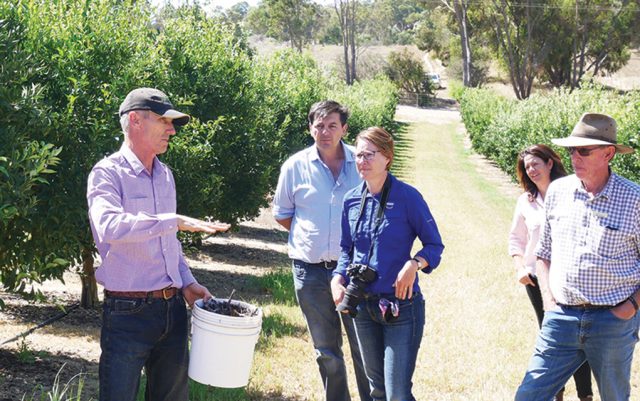Fueling the discussion on biological farming in the Northern Valleys region are local horticulture farmers Emma and Tom Mitchell, who on 27 February welcomed a bus full of delegates from the Department of Primary Industries and Regional Development (DPIRD) including Minister for Regional Development; Agriculture and Food, Alannah MacTiernan.
Agricultural scientists from UWA and other stakeholders joined the farm tour along with famed farmer, author and father of the regenerative agriculture philosophy Charles Massy to hear about how the Mitchells and other farmers in the region have used biological farming concepts to improve their farming practice.
Charles, who wrote Call Of The Reed Warbler to explain his revolutionary ideas on changing the way we farm and grow food, was in Perth speaking at several events including the Healthy Soil, Healthy Communities event run by Perth NRM.
He visited Tom and Emma’s farm prior to the DPIRD visit, where he was impressed with the level of soil health and biological activity on the 18 Ha West Gingin property where the Mitchells grow pumpkins, mandarins and limes.
Tom, a geologist by trade and Emma, who studied Agricultural science, say they can’t really pinpoint the moment they decided to pursue biological or regenerative farming methodology, but a struggle to rid their pumpkin crop of root knot nematode got them thinking about soil biology and health.
“When we started out, we considered the soil was just there to hold the plants up and we kept it as bare as possible,” explains Emma.
Like many farmers, they sprayed chemicals to control weeds, pests and disease, and added synthetic fertilizers to increase yields in their crops.
In combating the nematode, Tom began learning about different ways to encourage plant health and eliminate pests by looking after the soil, which led him to discovering the benefits of biological farming.
“I don’t like spraying chemicals and I don’t know a farmer who does,” he says, “An important aspect of biological farming is the health and well being of the farmers themselves. I feel better about the way I farm now – its healthier for me and my family.”
Attending a sustainable farming course in Queensland gave him confidence he was heading down the right track. And of course he has read Charles’ revolutionary book. Charles’ message of ‘Healthy landscapes lead to healthy food, and therefore healthy people and a healthy planet.’ struck a chord with Tom, who devoured the book in a few days.
“While it’s not a manual for biological farming methods and focuses mainly on case studies of broadacre farming, the book explains how the regenerative farmer thinks,” says Tom, who, along with Emma, eagerly embraced the concepts; together changing the way they farm their land.
On a practical level they have introduced cover crops, reduced tillage and encouraged good bugs back into the soil by adding compost and natural fertilisers. They have noticed a steady increase in yield despite a dramatic reduction of synthetic fertilisers and spraying as well as an increased resilience in their crops.
Listening to the call of their pumpkins, as well as the millions of other living organisms that make up the ecosystem on their property has certainly worked for Tom and Emma, and they encourage other farmers to read the book, and discover for themselves the potential of Charles’ ideas.








